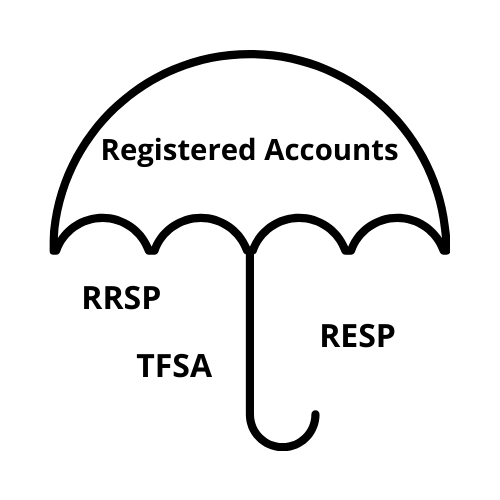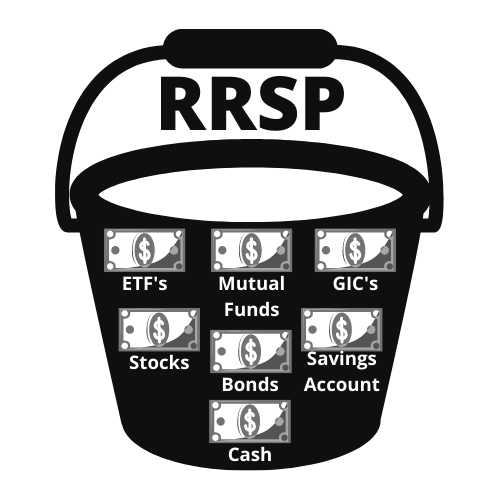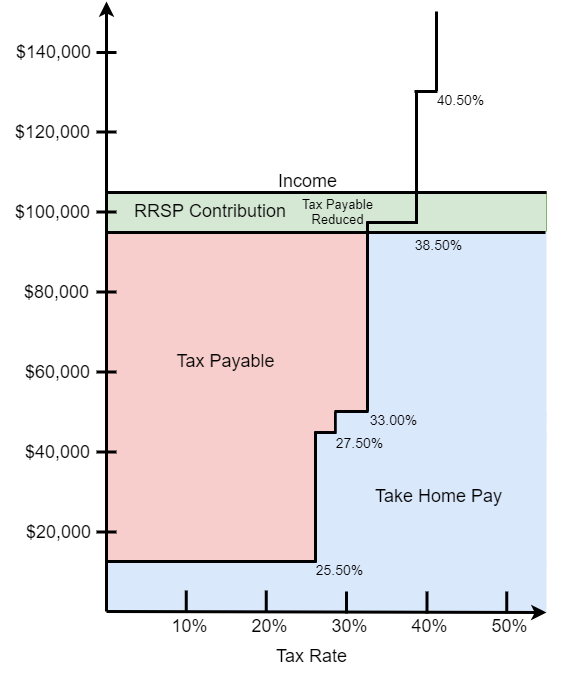Estimated reading time: 6 minutes
The Registered Retirement Savings Plan
I’m starting out with the basics #1: How an RRSP works.
RRSP’s are a type of account that falls under the registered umbrella in Canada. This means the account has special tax privileges and your contributions and withdrawals are tracked by the government (CRA).
Some other examples of registered accounts are the TFSA (Tax-Free Savings Account) and RESP (Registered Education Savings Plan). There are others, but we’ll focus on these as they are the main accounts when you are in the wealth accumulation phase of your life.

The RRSP Bucket
Think of RRSP’s as a bucket. They hold your funds that you want to accumulate for retirement. When people say “I’m going to invest in RRSPs”, what they really mean is that they’ll be holding their money in the RRSP bucket.
There are many investments that are RRSP eligible. These include ETF’s, mutual funds, GIC’s, stocks, bonds, and cash.

Tax Treatment
- When you contribute to an RRSP, you get a tax credit.
- When you withdraw funds, it is considered income and taxed at your marginal rate.
RRSP’s are considered a tax deferral strategy. They let you get a tax credit now and your investments can grow tax free until you withdraw them.
The Benefits of an RRSP
- RRSP contributions are tax deductible.
Reducing your taxable income for the tax year may provide a tax refund (other income and tax considerations needed). I enjoy receiving a refund to reinvest in my TFSA, building emergency savings, or to use it for yearly expenses like home insurance. - RRSP contribution room accumulates and you never lose it.
Your RRSP deduction limit (contribution room) is based on your pre-tax income (18% x income). If you make $100,000 your limit for the next will be $18,000. You never lose your contribution room until you use it so you can defer RRSP contributions until you are in a higher tax bracket. - Being in a lower tax bracket in retirement increases your RRSP benefit.
The RRSP provides an increasing benefit of your working vs. retirement income. For example, if you contribute at the 38.5% bracket and retire in the 33.0% bracket, you’ve essentially saved yourself 5.5% in tax plus the benefit of tax free growth. - RRSPs are great for mentally locking in your retirement funds.
Compared to TFSA’s, which do not trigger taxes when you withdraw, RRSPs trigger a withholding tax†. I find the withholding tax (and amount owed come tax time) is enough of a deterrent to NEVER pull money from my RRSP until retirement.
† Withholding Tax
Any withdrawals from your RRSP are subject to a withholding tax. The amount of tax owed depends on your total income for the year.
• If you withdraw up to $5,000, the withholding tax rate is 10%.
• If you withdraw between $5,001 and $15,000, the withholding tax rate is 20%.
• If you withdraw more than $15,000, the withholding tax rate is to 30%
The Drawbacks of an RRSP
- RRSP contribution room is not recoverable*.
If you pull money out of your RRSP for an emergency or for spending, you don’t get your contribution room back.
* There are exceptions with the Home Buyers Plan (HBP) and Lifelong Learning Plan (LLP) that allow you to pull money for specific purposes and you can repay it. - TFSA is a better option for lower income earners OR if your income will be equal/greater in retirement
If you are in a lower tax bracket, it can be more beneficial to contribute to your TFSA. Mathematically, I agree with this but from a behavioral finance perspective the TFSA is TOO easy to pull money from.
A Visual Example
In the example below, the individual has an income of $105,000 and has contributed $10,000 to their RRSP. This reduces their taxable income by $10,000. With that level of contribution, they’ve effectively reduced their marginal tax rate (the amount of tax paid on their next dollar earned) from 38.50% to 33.00% (5.5%).

** John Robertson is the author of “The Value of Simple”, a book I highly recommend for its straight forward approach to investing in Canada. You can also find his blog at holypotato.net.
The 38.50% tax rate begins at an income of $98,040 (Saskatchewan, 2021), which means they received a credit of $2,679.60 at the 38.50% bracket (($105,000 – $98,040) x 38.5%) and a credit of $1,003.20 at the 33% bracket (($98,040 – $95,000) x 33.00%). The total tax credit is $3,682.80, which is a 36.83% return on their $10,000.
This person has maximized getting as much money back as they can in the 38.50% bracket. Any additional RRSP contributions would net them an additional 33.00% credit on each dollar added.
Results
| Income | $105,000 |
| RRSP Contribution | $10,000 |
| Taxable Income | $95,000 |
| RRSP Tax Credit | $3,682.80 |
Another Example
If the person above was making over $130,506 (Saskatchewan, 2021) and had the RRSP contribution room for a $35,000 contribution (putting them under the $98,040/38.50% bracket), they would reduce their tax obligation from 40.50% to 33.00%. Lowering their marginal tax rate by 7.5% and skipping down two tax brackets.
This is where the RRSP really shines. Making contributions is great, but paying attention to your income and marginal tax rate can help you boost your credits.
In 2020, I had more income than normal, which put me into a higher tax bracket. Knowing what amount I needed to contribute to maximize my tax credits was key. If I would have waited to contribute past March of 2021, I wouldn’t have been able to maximize the credits from the higher bracket. This year I won’t move up into the higher bracket again.
Final Thoughts
As you can see, the RRSP is a powerful retirement tool here in Canada. Combined with automated saving, you can be well on your way to financial independence. If you are looking for ideas on how to save more, check out 10-year purchase mindset post or my savings calculator.
Stay tuned as I plan to break down how TFSA’s work and their benefits.
Please let me know your thoughts on why you love your RRSP!
A very detailed explanation of how an RRSP work. The best I’ve read so far.
I like your visuals for how an RRSP works. Another great benefit of the RRSP is that your contribution room accumulates over time (you don’t lose it annually). So you can accumulate RRSP contribution room in your lower income earning years and then use up that room later in your career once your income has increased.
Hi Maria,
Thanks, that’s a great point. I can add how it’s accumulated as well. I’m trying to keep things simple and accessible to new investors, so it’s easy to skip things. 🙂 Thanks for reading!